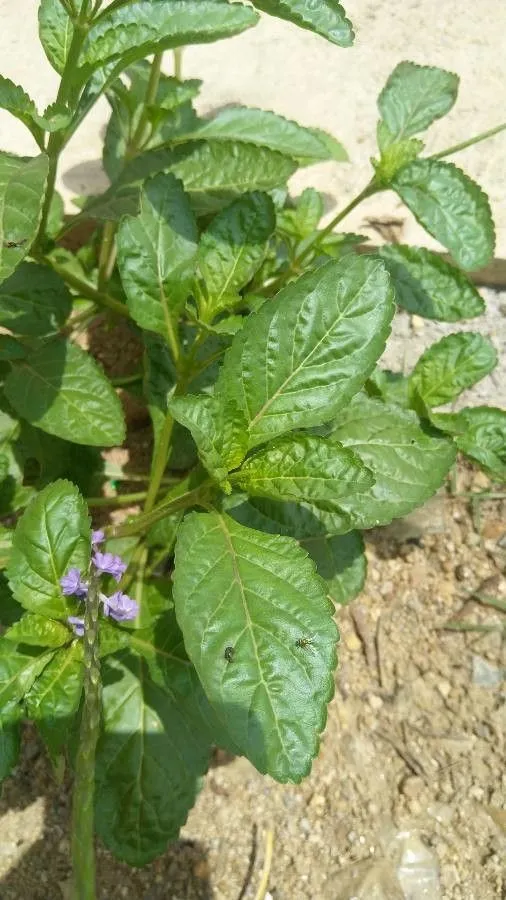
Author: (L.) Vahl
Bibliography: Enum. Pl. Obs. 1: 206 (1804)
Year: 1804
Status: accepted
Rank: species
Genus: Stachytarpheta
Vegetable: False
Observations: Mexico to Trop. America
Blue porterweed, scientifically known as Stachytarpheta indica, is a vibrant and enchanting plant that flourishes from Mexico to tropical regions of the Americas. Belonging to the family Verbenaceae, this plant is noted for its striking blue flowers and nettle-like appearance, which contribute to its common name.
The Blue porterweed is a hardy and adaptable species, thriving in a range of climates within its native geographical spread. Its ability to flourish in various environments makes it a popular choice among garden enthusiasts who desire a splash of color and a touch of tropical flair. Blue porterweed’s delicate, tubular flowers are a deep, royal blue, attracting a myriad of pollinators such as butterflies and hummingbirds. These blooms are arranged along slender, elongated spikes that elegantly rise above dark green foliage, creating a visually appealing contrast.
First recorded in the botanical literature “Enumeratio Plantarum,” authored by (L.) Vahl in 1804, the Blue porterweed has a long history of being appreciated for its ornamental value. Its lush growth and prolific blooming make it a favored addition to gardens designed to enhance biodiversity, support pollinator populations, and provide continuous seasonal interest.
Besides its aesthetic appeal, Stachytarpheta indica is recognized for its medicinal properties in traditional healing practices across its native range. Extracts from the plant are often used for their purported benefits, which include anti-inflammatory and analgesic properties. Such traditional uses underscore the plant’s cultural and ecological significance within its indigenous habitats.
In cultivation, Blue porterweed requires minimal care, making it an ideal choice for gardeners of all skill levels. It prefers well-drained soil and full sun to partial shade, ensuring robust growth and abundant flowering. Regular pruning can help maintain its shape and encourage denser foliage, enhancing the overall attractiveness of the plant.
In summary, Blue porterweed (Stachytarpheta indica) is an exceptional plant known for its ornamental and medicinal value. Rooted in the rich botanical history and widespread across tropical America, it continues to captivate gardeners and nature enthusiasts with its enduring beauty and utility.
Msa: herba, selasih dandi
En: Blue porterweed, Blue-vine, Brazilian tea, Burr-vine, Indian snakeweed, Jamaica Vervain, Jamaican Blue Spike, Jamaican Bluespike, Wild verbena, Bastard vervain, Light-blue snakeweed
Fr: Verveine, Verveine laquerot, Verveine queue de rat
Ms: Herba, Selasih dandi
Pt: Gervão-do-alagadiço
Taken Mar 13, 2022 by Berangere BATTIST (cc-by-sa)
Taken Apr 25, 2020 by Febin Joy (cc-by-sa)
Taken Apr 4, 2020 by kelly rica (cc-by-sa)
Taken Jan 25, 2020 by Burrows Kirsten (cc-by-sa)
Taken Sep 25, 2021 by lim wombat (cc-by-sa)
Taken Apr 30, 2021 by Orion Inko (cc-by-sa)
Taken Apr 25, 2020 by marc le (cc-by-sa)
Taken Aug 28, 2019 by Franco Colnago (cc-by-sa)
Taken Oct 15, 2019 by Mohammad Riyaz Pasha (cc-by-sa)
Taken Apr 25, 2020 by Febin Joy (cc-by-sa)
Taken Jan 9, 2022 by Maarten Vanhove (cc-by-sa)
Taken Mar 14, 2020 by Gileno Gustavo (cc-by-sa)
Taken Apr 25, 2020 by Febin Joy (cc-by-sa)
© copyright of the Board of Trustees of the Royal Botanic Gardens, Kew.
© copyright of the Board of Trustees of the Royal Botanic Gardens, Kew.
© copyright of the Board of Trustees of the Royal Botanic Gardens, Kew.
Family: Myrtaceae Author: (F.Muell.) K.D.Hill & L.A.S.Johnson Bibliography: Telopea 6: 402 (1995) Year: 1995 Status:…
Family: Rubiaceae Author: Pierre ex A.Froehner Bibliography: Notizbl. Bot. Gart. Berlin-Dahlem 1: 237 (1897) Year:…
Family: Sapindaceae Author: Koidz. Bibliography: J. Coll. Sci. Imp. Univ. Tokyo 32(1): 38 (1911) Year:…
Family: Asteraceae Author: A.Gray Bibliography: Pacif. Railr. Rep.: 107 (1857) Year: 1857 Status: accepted Rank:…
Family: Fabaceae Author: Medik. Bibliography: Vorles. Churpfälz. Phys.-Ökon. Ges. 2: 398 (1787) Year: 1787 Status:…
Family: Aspleniaceae Author: (Cav.) Alston Bibliography: Bull. Misc. Inform. Kew 1932: 309 (1932) Year: 1932…